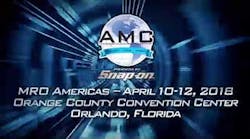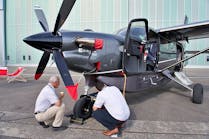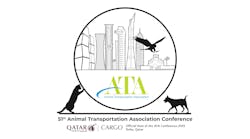Wanted: Skilled Technicians for Rewarding Career in Aviation Maintenance
While it comes as no surprise that the aviation maintenance industry is facing a looming shortage of qualified technicians, the question that remains up for debate is how to close that gap.
Data recently released by the Aviation Technician Education Council (ATEC) found that new entrants make up 2 percent of the AMT population annually, while 30 percent of the workforce is at or near retirement age. That’s not a very encouraging statistic, especially compared to Boeing’s 2016 forecast that 679,000 new commercial airline maintenance technicians will be needed globally by 2035.
Although there doesn’t seem to be any quick-fix to the issue, some believe the industry suffers from a public relations problem, and that it needs to reinvent its image to appeal to a wider audience. Select teams and organizations participating in the Aerospace Maintenance Competition (AMC) Presented by Snap-on, weighed-in on what can be done to better position the industry as an attractive career choice. Crystal Maguire, executive director, ATEC (www.atec-amt.org), thinks the key is reaching people when they’re young … very young.
Two-Pronged Approach
Maguire believes the key to building more interest in aviation maintenance is through better training, and developing alliances between industry and schools.
Maguire says ATEC, whose mission is to promote and support aviation maintenance technical education, has been working alongside schools and the industry to update areas of the FAA’s Part 147 curriculum requirements to more accurately reflect the minimum certification standards that enable graduating students to be more proficient on the job. These suggested updates include additional training on today’s highly technical aircraft, along with dropping some aptitude mandates on systems found on older aircraft that they’re not likely to see on the job.
ATEC is also working with industry leaders on a branding campaign to better define what it means to be in aviation maintenance, and ultimately deliver those key messages to students in K-12 schools and postsecondary schools. The industry’s ability to successfully reach students at an early age and show them that a career in aviation is a viable option may be a long-term solution to help alleviate the technician shortage, she says.
“If you have a school in your area that you can partner with and reach out to those students, that would be ideal. Industry just needs to get involved,” she says. “It’s really about building partnerships. We believe there’s a lot of value in bringing companies and schools together to get the message out that aviation maintenance is a viable industry to be part of.
“Everyone is talking about the need to increase awareness of aviation maintenance, and I think ATEC is in a good position to help facilitate this because we are the common denominator.”
Show and Tell
Ken MacTiernan agrees with Maguire that adapting a more proactive stance to reach youngsters would pay dividends in the long run. MacTiernan, an aircraft maintenance technician with American Airlines, and chairman of the Aerospace Maintenance Competition, believes that young people need to be exposed to what a career as a AMT is like.
Events like career days and giving youngsters the opportunity to interact with AMTs and see aircraft up close would help put the career on their radar.
“Explaining and demonstrating a technician’s entry into our craft would go a long way,” he says. “Ours is a profession that can really entice kids. When you’re in this industry, you’re going to be in an environment in which everyone shares the same responsibilities. I think showing them the pros of being an AMT would be effective.”
College Partnerships
Some airlines “across the pond” are feeling the effects of the technician shortage as well.
“It’s definitely a challenge. I’ve been in touch with other MROs that are having similar issues,” says Tim Privett, base maintenance production manager for Flybe Aviation Services, the maintenance arm of Flybe, Europe’s largest regional airline. “Depending on which research you believe, it’s going to get a lot worse or just a little bit worse over the short and medium term. But it’s definitely a challenge trying to attract the right people.”
Privett believes the dip in interest stems from more people attending universities and not considering aviation or other skilled trades as a career.
One way Flybe is addressing the issue is through the creation of an apprenticeship program with a local college. Each year the program accepts 25 to 30 applicants, who complete a mix of traditional college coursework and hands-on aviation training. Flybe’s aeronautical apprenticeship is a four-year program leading to a Level 3 Diploma in aviation maintenance, and an EASA Category A License is delivered at the Flybe Training Academy and Maintenance Repair Organization.
“The program gives us some homegrown, well-trained, reasonably experienced techs at the end of four years,” Privett says. “At the moment the program is focused on having students receive their EASA license, but we’re looking to change that to more of a 50-50 split, where half the students complete training to receive their license, while the other techs acquire more structures and avionics skills. Our goal is to get a broad mix of trained students.”
Two members of Flybe’s team that competed in the Aerospace Maintenance Competition last year were graduates of the airline’s engineering apprenticeship program, and Flybe is competing in this year’s event as well. Privett says the program has been well received since it started about 10 years ago, as they regularly receive many more applicants for the 25 to 30 slots.
This type of partnership is fairly common across the aviation industry. Altus Air Force Base, Oklahoma, works in conjunction with Southwest Technology Center (https://www.swtech.edu) to train civilian technicians on maintaining the base’s fleet of C-5, C-17, and KC-135 aircraft. The newly redesigned program, called Pathways Recent Graduate, allows students to focus on their studies, and when they graduate, they’re hired on full-time at the base. Local high school graduates can enter the program and receive free tuition. The program was initially designed to inspire students to stay in the area, as the base traditionally has had difficulty attracting technicians to Southwest Oklahoma, where Altus AFB is located.
To date, 221 have entered the program, with 138 still employed; about 30 students are expected to graduate from the program this spring. A team of civilian technicians will be fielding a team at this year’s AMC.
“The Recent Grad program gives the 97th Maintenance Group the flexibility to hire more trainees, which is extremely beneficial,” says Brandi Roblez, personnel liaison, 97th Maintenance Operations, Altus AFB.
Strong Staffing
On the other hand, the U.S. Coast Guard, with its 92 percent retention rate in maintenance, isn’t nearly feeling the effects of a technician shortage.
“To be able to keep that many of your young people, with an 8 percent loss rate, is pretty good,” AMT Rating Force Master Chief Kit Harris says.
Although the Coast Guard’s technician staffing levels are high now, Harris said it’s cyclical as the rate of retirees can affect staffing from year to year.
He attributes the high retention rate to the Coast Guard’s culture of taking care of people, and overall satisfaction with the Coast Guard’s mission. Last year, the Coast Guard fielded two teams in the AMC, one of which paid their own way to compete in Orlando.
“Those guys just had a strong desire to compete,” he says of the team from Coast Guard Air Station Clearwater, FL, “They wanted to go down and show their stuff.”
And show their stuff they did, as the team won first place in the AMC’s military category.
Mentoring Women
One challenge that’s prevalent throughout aviation maintenance is how to attract more females to the industry. Kendra Kincade thinks she may have the answer. Kincade founded Elevate Aviation (http://www.elevateaviation.ca), a nonprofit organization whose mission is to introduce women to careers in aviation. The main strategy behind Elevate Aviation is to team up women with female mentors within the industry to give them a better idea of what a career as a pilot, air traffic controller, flight attendant, or technician looks like.
“We’re trying to get out there and raise awareness about these careers,” she says. “For aircraft mechanics, the idea is to go out and job shadow them. She can show you the ropes, show you what it’s like to work there, so you’ll have a better idea of what a career as an AMT is like."
Founded in 2011 in Edmonton, Alberta, Canada, Elevate Aviation has mentored more than 500 women in several aviation disciplines. Kincade is looking to broaden Elevate Aviation’s reach south of the boarder and establish female mentors in the United States by the end of the year … and that’s one of the reasons why she’s bringing a team this year to the AMC.
“We don’t have a lot of women looking at aircraft mechanics because they’re not thinking about it. That’s why we’re competing in the AMC; we need to get this out there and raise awareness. We just want to try and get women to look at maintenance as a career.”
The Aerospace Maintenance Competition Presented by Snap-on will be held during the MRO Americas 2018 Convention (http://mroamericas.aviationweek.com/am18/Public/Enter.aspx), April 9-12 in Orlando (https://www.aerospacecompetition.com/).
Steve Staedler is a senior account executive at LePoidevin Marketing, a Brookfield, WI-based business-to-business marketing firm that specializes in the tooling and aerospace industries. Staedler has been covering aeronautical maintenance for more than 10 years; is a former newspaper reporter and retired master sergeant from the U.S. Air Force Reserve, where he worked maintenance and public affairs. He can be reached at [email protected]; (262) 754-9550.




